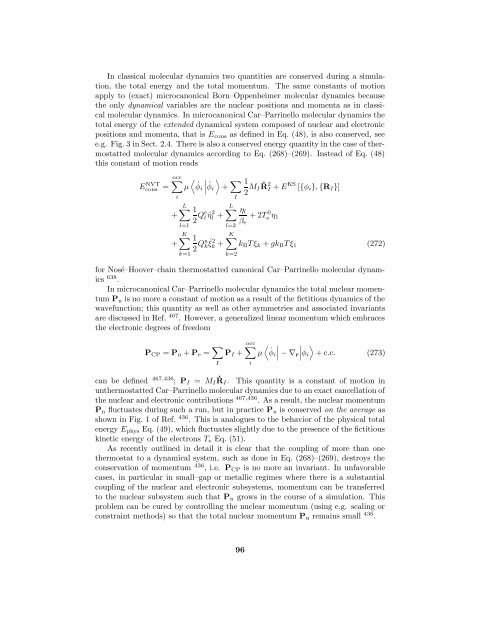Ab initio molecular dynamics: Theory and Implementation
Ab initio molecular dynamics: Theory and Implementation
Ab initio molecular dynamics: Theory and Implementation
- No tags were found...
You also want an ePaper? Increase the reach of your titles
YUMPU automatically turns print PDFs into web optimized ePapers that Google loves.
In classical <strong>molecular</strong> <strong>dynamics</strong> two quantities are conserved during a simulation,the total energy <strong>and</strong> the total momentum. The same constants of motionapply to (exact) microcanonical Born–Oppenheimer <strong>molecular</strong> <strong>dynamics</strong> becausethe only dynamical variables are the nuclear positions <strong>and</strong> momenta as in classical<strong>molecular</strong> <strong>dynamics</strong>. In microcanonical Car–Parrinello <strong>molecular</strong> <strong>dynamics</strong> thetotal energy of the extended dynamical system composed of nuclear <strong>and</strong> electronicpositions <strong>and</strong> momenta, that is E cons as defined in Eq. (48), is also conserved, seee.g. Fig. 3 in Sect. 2.4. There is also a conserved energy quantity in the case of thermostatted<strong>molecular</strong> <strong>dynamics</strong> according to Eq. (268)–(269). Instead of Eq. (48)this constant of motion readsE NVTcons =∑occi++〈 ∣ 〉 ∣∣µ ˙φi ˙φi + ∑ IL∑l=1K∑k=1L12 Qe l ˙η2 l + ∑ η l+ 2Te 0 β η 1e12 Qn k ˙ξ 2 k +l=212 M IṘ2 I + E KS [{φ i }, {R I }]K∑k B Tξ k + gk B Tξ 1 (272)k=2for Nosé–Hoover–chain thermostatted canonical Car–Parrinello <strong>molecular</strong> <strong>dynamics</strong>638 .In microcanonical Car–Parrinello <strong>molecular</strong> <strong>dynamics</strong> the total nuclear momentumP n is no more a constant of motion as a result of the fictitious <strong>dynamics</strong> of thewavefunction; this quantity as well as other symmetries <strong>and</strong> associated invariantsare discussed in Ref. 467 . However, a generalized linear momentum which embracesthe electronic degrees of freedomP CP = P n + P e = ∑ I∑occ〈 ∣ ∣ 〉 ∣∣ ∣∣φiP I + µ ˙φi − ∇r + c.c. (273)ican be defined 467,436 ; P I = M I Ṙ I . This quantity is a constant of motion inunthermostatted Car–Parrinello <strong>molecular</strong> <strong>dynamics</strong> due to an exact cancellation ofthe nuclear <strong>and</strong> electronic contributions 467,436 . As a result, the nuclear momentumP n fluctuates during such a run, but in practice P n is conserved on the average asshown in Fig. 1 of Ref. 436 . This is analogues to the behavior of the physical totalenergy E phys Eq. (49), which fluctuates slightly due to the presence of the fictitiouskinetic energy of the electrons T e Eq. (51).As recently outlined in detail it is clear that the coupling of more than onethermostat to a dynamical system, such as done in Eq. (268)–(269), destroys theconservation of momentum 436 , i.e. P CP is no more an invariant. In unfavorablecases, in particular in small–gap or metallic regimes where there is a substantialcoupling of the nuclear <strong>and</strong> electronic subsystems, momentum can be transferredto the nuclear subsystem such that P n grows in the course of a simulation. Thisproblem can be cured by controlling the nuclear momentum (using e.g. scaling orconstraint methods) so that the total nuclear momentum P n remains small 436 .96









